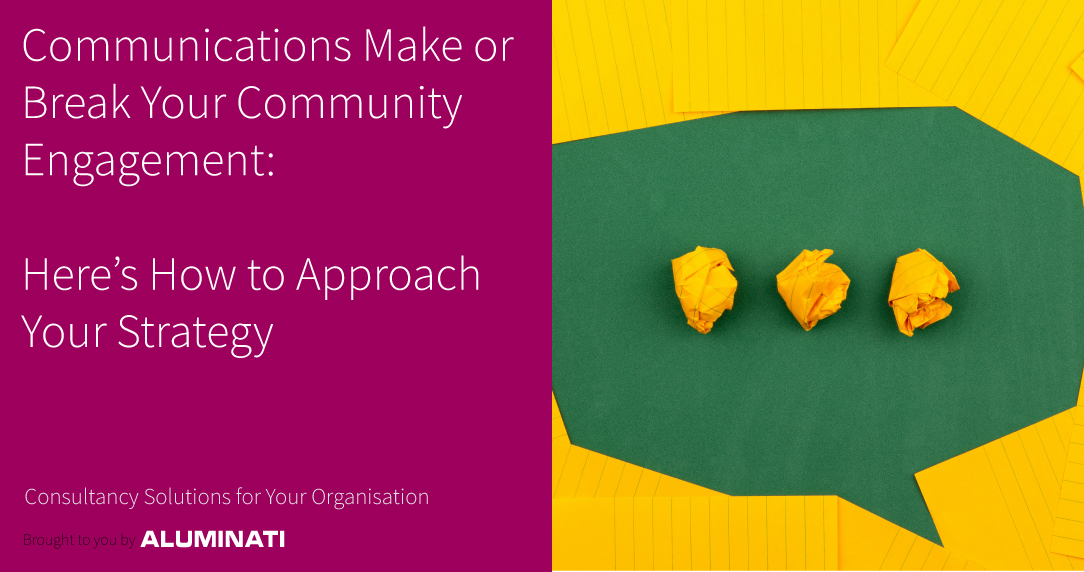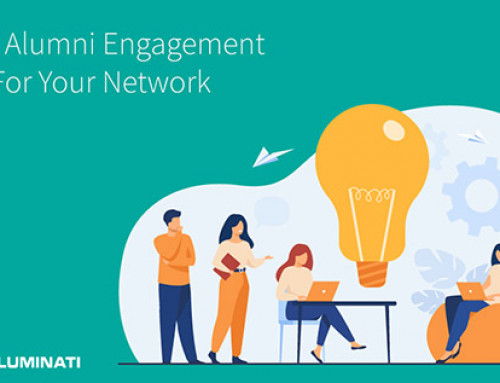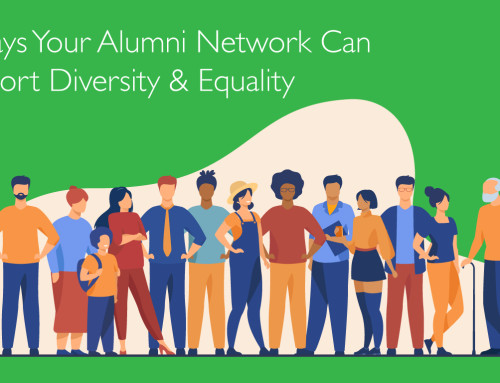Have you ever received an email from an organisation or company that very clearly offered no value to you, or maybe even didn’t seem to be relevant to your context? It’s statistically likely that you have: a 2019 report showed that only 55% of marketers think that the majority of the emails their organisation sends are relevant to the individual participant. In other words, lots of people candidly admit that they regularly and repeatedly send irrelevant emails.
As a Community Builder, you want to do everything in your power to NOT send those kinds of emails.
Try to remember what it felt like when you received an email that felt irrelevant to you. Chances are, you are experiencing one of two things:
1. You can’t remember it at all (because that’s the extent of an impact it made on you; you quickly deleted it from your inbox and from your mind as well!)
2. You’re recalling the slight feeling of irritation that you probably directed at the company or organisation that sent you that unhelpful email in the first place. (Did you unsubscribe from their mailing list?)
Those reactions are precisely why you don’t want to be the one sending that kind of email.

So, as a Community Builder: how do you craft a communications strategy that allows you to reach your target audience with interesting and relevant content? We all know that providing audiences with interesting and relevant content will increase engagement and thus bolster the overall engagement that your community members have with your community. But how do you go about understanding what counts as interesting, relevant, and engaging? And how regularly should you send it out to your members?
Our Aluminati Consultant team offers facilitation sessions where we interactively guide community builders like you to develop a communications plan that fits your community, and which takes into account your team’s resources.
You can book a free discovery call with me in order to learn more about this, or any other service that the consultancy team offers. We’d love to support you in crafting and delivering excellent communication that engages your community members; a guided session that is curated to your context is the best place to start!
In the meantime, here are three of our top tips, all of which involve segmentation of one kind or another. These tips are aimed specifically at Community Builders who are launching a new community or introducing a new element into an existing community.
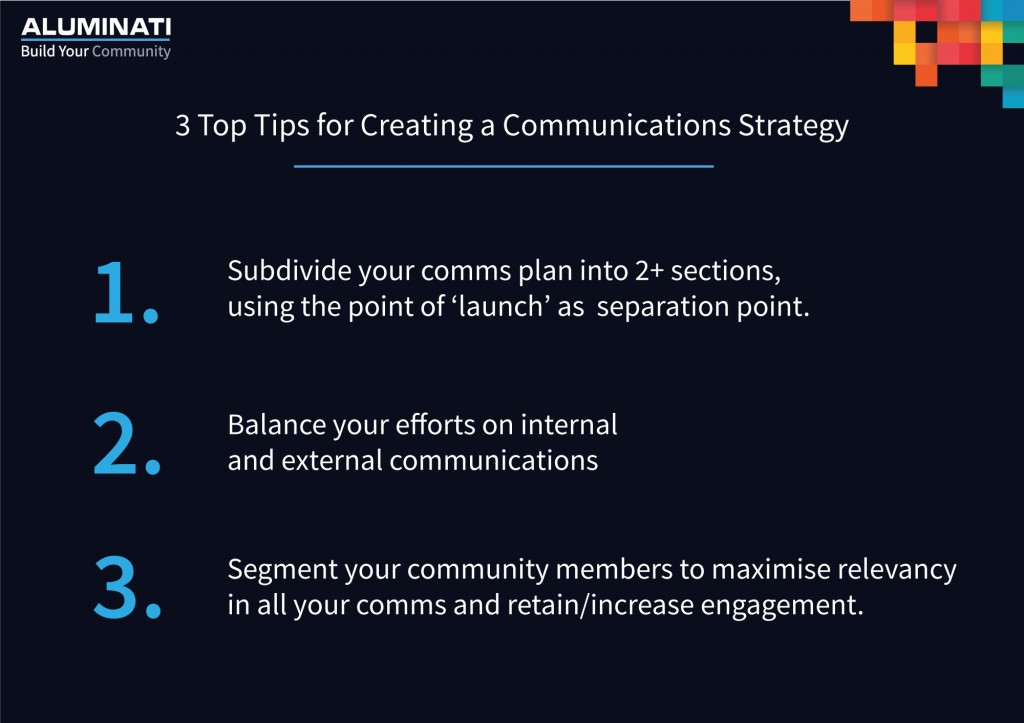
1. Start by subdividing your communications plan into two sections, using the point of “launch” as a separation point.
This means you will have 2+ sections to consider: leading up to launch (where you’ll focus on generating awareness and reconnecting with folks who may have dropped off your radar) and after launching (where you’ll focus on continuing to engage and thus retain your members).
Thinking of your project launch in this way is part of project planning, which we’ve addressed separately in a different post.
2. When you create your communications plan, make sure you are thinking about both internal and external communications.
Internal communications include sharing information back to your team or other internal stakeholders who have funded your community or have a vested interest in its success. External communications include things that are targeted at your community members (both current and prospective) and could also include more generic communications, such as a local press release that highlights the initiatives your community is going for.
Some of this content can overlap: for example, both internal and external communications could include something like a successful and inspiring story from someone who experienced demonstrable benefit from your community. This is the sort of qualitative feedback and insights which is hard to quantify but which we know is extremely valuable in showing the impact that your community is having and thus increasing your value proposition.
Other parts of this content will only be relevant for either internal or external. For example, an impact report which quantifies some of the success metrics should be directed to your internal stakeholders who have invested in the community. (We recommend that you do a mico-report quarterly and a more in-depth report annually.) On the other hand, announcements about a new feature that your community platform now uses are probably going to be relevant to the community members, but not to non-member stakeholders.
3. Segment your community members into different groups. This step is vital in order to not fall into the trap of sending out communications that people feel are irrelevant.
Even after you’ve segmented your communications strategy by time periods and by what reaches your internal vs external audiences, you still need one more step: segment your community members into different groups. This is a crucial step to understanding your users, which we’ve written here.
One way to break down your broader community members into smaller sub-groups for the purpose of creating targeted communications for them is to create “personas” –something that we will cover in more detail in our upcoming Creating Connections webinar on 1 Dec 2021.
It’s important to have micro-groups within your community, otherwise, you risk overwhelming everyone with information that is not relevant to them. As it is, organisations and companies already struggle to get people to open up emails. (NB: as I write this, I have 948 unopened emails in my personal inbox–don’t worry, they’re not from you, I promise!)
People simply don’t open up emails that don’t seem relevant. In the higher education context, emails have an open rate of 17.81%. Because it’s already a feat to have someone open up your email in the first place, you want to make sure that, when they start reading your email, it will feel relevant and even useful to them.
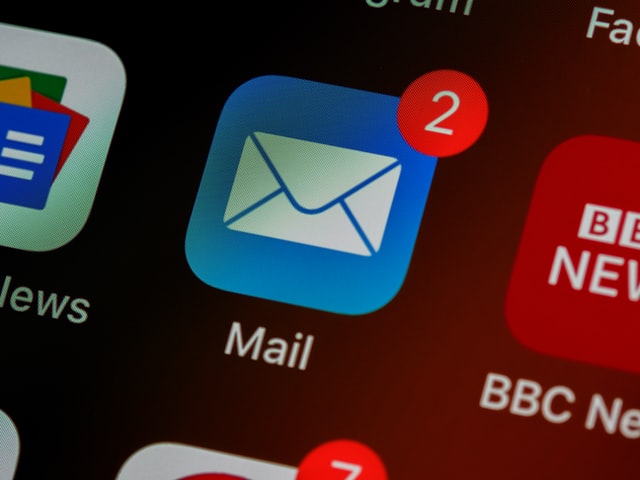
Relevant emails can make or break your members’ ongoing engagement
Let me tell you about an example from my own experience to illustrate this further. When I graduated with my undergraduate degree, I officially became an alum of the University (hooray!)…. and I promptly started getting emails from said University about whether or not, as an alum, I would be interested in making a financial donation. On the exact same day, I received a different email reminding me about the student debt I had to pay off.
Now, as you can imagine, as a jobless & debt-paying alum, I was not at all in a position to make a financial donation to the university. Was I technically an “alum” as far as the university was considered? Yes, absolutely. But the university had not taken the time to segment its alumni into smaller segments based on their stages of life, needs, wants, desires, pain points, etc. Instead, all alumni (presumably) received that same email about making a donation–no matter the fact that some of us still had to pay off substantial debt from their university education!
So, I repeat: segmenting your community members into smaller groups is VITAL to maintaining their engagement.
What did I do upon receiving the irrelevant email? I promptly unsubscribed from the alumni mailing list. This is truly a misfortune (one that I have since rectified!) because there are so many ways other than financial donation that alumni can be engaged–something that Maria Gallo and Jay Dillon have both recently explored as guests in our Creating Connection Webinar series.
As Community Builders, we have to ask ourselves: what type of information can I provide to which type of community members in order to make their experience one that is relevant and helpful?
This is why we guide our clients to think of their community members through THEIR perspective rather than from YOUR perspective. This is about crafting a user-centric experience, rather than an organisation-centric experience. If you’re in the higher ed world and you’re building a community for alumni, you’ll want to think through questions such as: How long ago did this alum graduate? Have they secured a job? What sector do they work in? What stage of their career are they in? What do they want and need from being a part of this community?
Thinking through your community member’s identities from their experiences will help you to segment them into identity groups. You can then contact each identity group with information that is relevant to them, and not fill their inboxes with information that is irrelevant or unhelpful.
There are many more tips and best practices to incorporate into your communications plan, but we’ve found that Community Builders who follow these three tips are already off to a great start. If you want more information about how our consultant team can help you craft and deliver a communications strategy, book a free discovery call with one of our consultants to discuss the option that is best for you.
